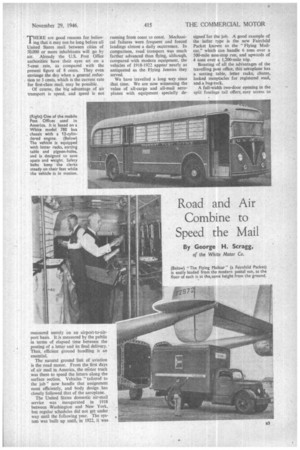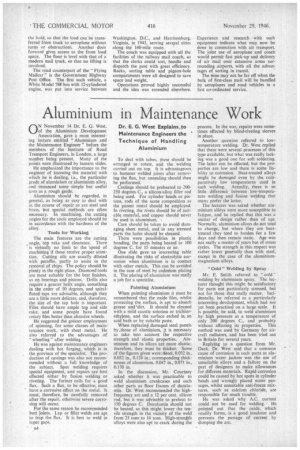Road and Air Combine to Speed the Mail
Page 37

Page 38

If you've noticed an error in this article please click here to report it so we can fix it.
By George H. Scragg,
of the White Motor Co.
T'THERE are good reasons for believing that it may not be long before all United States mail between cities of 50,000 or more inhabitants will go by air. Already the U.S. Post Office authorities have their eyes set on a 5-cent rate, as compared with the present figure of 8 cents. They even envisage the day when a general reduction to 3 cents, which is the current rate for first-class mail, may be possible.
Of course, the big advantage of air transport is speed, and speed is not
measured merely on an airport-to-airport basis. It is measured by the public in terms of elapsed time between the posting of a letter and its final delivery. ' Thus, efficient ground handling is an essential.
The natural ground link of aviation is the road motor. From the first days of air mail in America, the Motor truck was there to speed the letters along the surface section. Vehicles "tailored to the job" now handle that assignment most efficiently, and body design has closely followed that of the aeroplane.
The United States domestic air-mail service was inaugurated in 1918 between Washington and New York, but regular schedules did not get under way until the following year. The system was built up until, in 1922, it was running from coast to coast. Mechanical failures were frequent and forced landings almost a daily oceurrence. In comparison, road transport was much farther advanced than flying, although, compared with modern equipment, the vehicles of 1918-1922 appear nearly as antiquated as the Flying Jennies they served.
We have travelled a long way since that time. We are now witnessing the value of all-cargo and all-mail aeroplanes with equipment specially de
signed for the job. A good example of the latter type is the new Fairchild Packet known as the "Flying Mailcar," which can handle 6 tons over a 500-mile non-stop run, and upwards of 4 tons over a 1,200-mile trip.
Boasting of all the advantages of the travelling post office, this aeroplane has a sorting table, letter racks, chutes, locked receptacles for registered mail, and a bag-rack.
A full-width two-door opening in the split fuselage tail offers_ easy access to the hold, so that the load can be transferred from truck to aeroplane without turns or obstructiods. Another door forward gives access to the front load space. The floor is level with that of a modern mail truck, so that no lifting is involved.
The road counterpart of the " Flying MaiIcar " is the Government Highway Post Office. The first such vehicle, a White Model 788 bus with 12-cylindered engine, was put into service between Washington, D.C., and Harrisonburg. Virginia, in 1943, serving sevezal cities along the 140-mile route.
The coach was equipped with all the facilities of the railway mail coach, so that the clerks could sort, handle and dispatch the post with great efficiency. Racks, sorting table and pigeon-hole compartments were all designed to save space and weight.
Operations proved highly successful and the idea was extended elsewhere. Experience and research with such equipment indicate what may now be done in connection with air transport. The joint use of aeroplane and coach would permit fast pick-up and delivery of air mail over extensive areas surrounding .airports, with all the advan tages of sorting in transit. • The time may not be far off when the bulk of first-class mail will be handled by aeroplanes and road vehicles in a fast co-ordinated service.
























































































